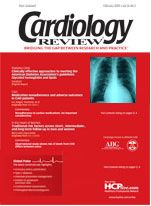Publication
Article
Cardiology Review® Online
HDL better predictor of ischemic stroke than LDL, triglycerides
NEW ORLEANS—High-density lipoprotein (HDL) cholesterol can predict subsequent acute ischemic stroke, whereas low-density lipoprotein (LDL) cholesterol and triglycerides are not significantly associated with ischemic stroke. Furthermore, increasing HDL cholesterol appears
to significantly lower the risk of
ischemic stroke, said William J. Jones, MD, at the American Stroke Association’s International Stroke Conference 2005.
He and colleagues examined the relationship between HDL cholesterol and stroke in 7,506 subjects from a large, public teaching hospital health care system who had at least two measurements of HDL cholesterol. In this retrospective study, 486 patients suffered an ischemic stroke during follow-up. After adjustment for common known vascular risk factors (ie, age, sex, race, smoking status, systolic blood pressure, and history of hypertension or diabetes), an increase in HDL cholesterol from baseline to follow-up was associated with a significant reduction in stroke. Each 10-mg/dL increase in HDL cholesterol was associated with a 14% reduction in the risk of ischemic stroke (P = .003). In contrast, LDL cholesterol and triglycerides were not significantly predictive of the risk of acute ischemic stroke.
Although National Cholesterol Education Program guidelines (Adult Treatment Panel III) are directed at reducing the risk of coronary heart disease (CHD), “our results are somewhat at odds with the guidelines, which emphasize LDL cholesterol as the target for lipid therapy and monitoring,” said Dr. Jones, assistant professor of neurology/health services researcher, Roudebush VA Medical Center, Indiana University, Indianapolis.
The results of the study suggest that HDL cholesterol may be an appropriate target of therapy to reduce the risk of cerebrovascular disease. To date, only one study—the VA HDL Intervention Trial (VA-HIT)—has examined the effect of raising HDL cholesterol on stroke risk. In VA-HIT, the risk of stroke was reduced by 31% among men with CHD, LDL cho-
lesterol lower than 140 mg/dL,
and HDL cholesterol lower than 40 mg/dL who were randomly assigned to gemfibrozil compared with placebo.
The current study also suggests that the risk of stroke attributed to LDL cholesterol may depend on a patient’s HDL cholesterol level.
Lipid-management guidelines specific for cerebrovascular disease need to be developed and may differ from those intended to reduce the risk of cardiovascular disease, said Dr. Jones. “We’re not ready yet to develop guidelines because of the lack of data, but we may need to incorporate HDL into any guidelines,” he said. Another question that needs to be answered is whether or not lowering LDL cholesterol in patients with high HDL cholesterol will make a difference with respect to stroke risk.
In other data presented here, investigators from Columbia University in New York City, led by Mitchell S. Elkind, MD, assistant professor of neurology, found that patients taking lipid-lowering agents, particularly HMG-CoA reductase inhibitors (statins), at the time of their acute ischemic stroke had less severe strokes and lower mortality at 90 days than those not taking lipid-lowering agents. As part of the Northern Manhattan Stroke Study, they identified 650 patients with acute ischemic stroke, assessing their stroke severity using the National Institutes of Health Stroke Scale (NIHSS) and collecting 90-day mortality data.
Of the 650 patients, 57 were taking lipid-lowering therapy at the time of stroke. The type of lipid-lowering therapy could be ascertained in 44 patients, 90.9% of whom were taking a statin.
Strokes were considered mild (NIHSS score of 0 to 5) in 50.7% not on a lipid-lowering agent and in 58.9% of those on lipid-lowering therapy. Severe strokes (NIHSS score of 14 ) were more common in those not on lipid-lowering agents; 16.8% of those not on a lipid-lowering drug had a severe stroke compared with 10.7% of those taking lipid-lowering drug therapy. Mortality at 90 days was 11.2% in the group not taking a lipid-lowering agent compared with 1.6% of those on a lipid-lowering drug (P = .017). n
